June 23, 2011
March 7, 2010
Holi program 2066
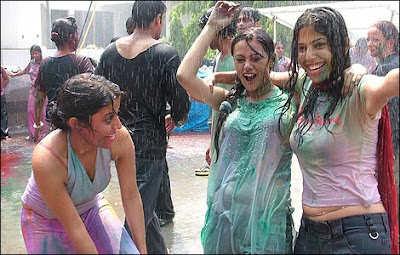

होली (Sanskrit), Holi, or Holli, also called the Festival of Colors, is a spring festival celebrated by Hindus, Buddhists, Sikhs and others. It is primarily observed in India, Nepal, Sri Lanka,[1] and countries with large Indic diaspora populations, such as Suriname, Guyana, South Africa, Trinidad, United Kingdom, United States, Mauritius, and Fiji. In West Bengal of India it is known as Dolyatra (Doul Jatra) or Basanta-Utsav ("spring festival"). The most celebrated Holi is that of the Braj region, in locations connected to the god Krishna: Mathura, Vrindavan, Nandagaon, and Barsana. These places have become tourist destinations during the festive season of Holi, which lasts here to up to sixteen days.
The main day, Holi, also known as Dhuli Vandana
The holi program of the mirmee syangja's group at kathmandu named "Holi mirmee" and all friend are celebreating as"The holi mirmi 2066" kathmandu. for photos click here
February 21, 2010
How to Change Windows Time Display to Include Your Name
1.Navigate to START → Settings → Control Panel.
2.Double click on Regional and Language Options, if you are in Classic View. Otherwise, click on Date, Time, Language, and Regional Options, then click on Regional Options. You should see the following window:

>
3.Click on the Customize.
4.Click on the Time tab. You should see:

5.Replace the AM and PM with your first name.
6.Click on Apply.
7.Click on OK.
8.Close the Regional and Language Options window
Log off Your Classmate's Computer
Steps
1.Make sure you're in a lab with numbered computer names. To check, go to your start menu, right click My Computer, and select properties.
2.Check the computer name. If it is something like school22, then check the computer next to you. If it says something like school21 or school23 then you are on the right track.
3.If the guy you want to attack is on computer number 17 then write down your computer name and instead of the number on your computer replace it with 17.
4.Go to Start, Accessories, Communications, Remote Desktop Connection
5.Then in the RDC (Remote Desktop Connection) Type in the computer name with the selected number in this case 17, so it should be school17.
6.Click Connect.
7.Type in your school username and password (if you have one). If you don't want to get in trouble, type in the public school username.
8.It should say something like "The user
9.They should be logged off, but be careful. The computer logged off should say "this computer is locked by
10.Now do what you want to the computer. Shut it down or just stay on it and annoy them.
11.If you cannot get the computer name, go into command prompt and type "net view" and it will list all the computers on the network.
Tips
Make sure your computer is using Windows XP or 2000.(windows vista has RDC, but
it can't recive RDC connections. It can only send them. So it wont work with Vista.)
This will be easier if the computers have numbers on them, like 21 or 23 so then if you find the computer name just remove the number and add the number of the computer you wish to attack.
Some computers may not have the desired computer name.
Your school computers may not be networked together, which means they cannot be accessed through RDC. However, you will probably have networked computers, so don't worry.
If you stay on the computer, they can't log on unless you get off.
This will not work if your school does not permit remote desktop.
If Remote desktop connection cannot be found, open up a browser (Mozilla Firefox preferred) and type in C: > Windows > System32 > Ctrl+F and search for mstsc.exe and save it to a folder. Voila you have RDC
edit WarningsThis will show the computer the username who logged you off, so use the public school username if you can.
This can allow hackers to get in your computer so be careful
Some schools have found ways to prevent the use of RDC
November 19, 2009
How to Make an Invisible File
1.Create a new folder.
2.Right Click -> New -> Folder, and a new folder should be created.
3.Customize the icon. Don't rename it just yet. Right Click the New Folder, go to Properties, then to Customize, and then Change Icon. Here is the trick, go to the middle and you should see some blank spaces. Those are transparent icons, select one of those then press OK -> Apply -> OK.
4.Name your folder. Press rename and instead of the file press ALT+0160 (Remember to keep the ALT button pressed down while typing the numbers).
5.You should have finished your new invisible file, Congratulations.
6.Remember, you must do the numbers in the key pad.
(To show your hidden files/fold/icon, do the following:
Double click my computer icon
Click tools, then folder options.
When the window pops up, click view on the top tab.
Then look for the show hidden files and folder.
And when you have found it, click on show hidden files and folder
Click apply or ok. )
September 13, 2009
How to Hack Windows
2. Dialog will appear: you're going to want to go down to the bottom and select "All Files". Then you are going to name the file: Batch.bat. After that, go to where you saved it, and open it. That will open up Command Prompt.
3. However, if the computer has notepad blocked, you can easily go to any web page and then go to "View>View Source". That will easily open up Notepad.
4. After that, you will be able to do as you wish inside command prompt. Here is how to add or delete accounts:
*Add Account: C:>net user USERNAME /add
*Change Accounts password: C:>net user USERNAME * then you'll be able to enter a new password for the account. If you just press enter without typing anything, the account password will be reset.
*Delete Account: C:>net localgroup Administrators# # Another way is to open up notepad, (if its not blocked), and type in "command.com". Then goto File->Save As. A USERNAME /ADD
Tips
*Don't be an idiot and mess up someone else's computer. Only do anything like this if you need access to the root of Windows. It was written for learning only. Also, don't try anything unless you know something about DOS.
*Its much more fun to use the Emergency Boot CD... check it out.
September 11, 2009
Set up Your Laptop to Print Wirelessly
1 Make sure that the printer is connected to the network.( Make sure your PC contains a wireless adapter preferably already configured to connect to your router.
Make sure your printer contains a wireless adapter or if the printer contains a network adapter setting it up is a simple as plugging the printer into your wireless router (if you don't have a router you can use ad-hoc mode but this monopolizes your wireless adapter in your PC).
You need to connect your printer (as you would any other wireless personal computer or device) to your wireless router (or AirPort if its a Mac), so turn both the printer on and router (if you have one) on.
Can your printer detect your wireless router? If your printer doesn't have a small screen you'll probably have to plug it into your PC (via USB) and set it up to connect to the network via your PC. If your printer has a small screen it should recognise any wireless routers within range (these might be called airport, belkin, buffalo, d-link, linksys, netgear, verizon or zoom). If it cannot make sure your router is configured to accept all devices which try to connect (with the correct password) not just your PC. Some routers are set up to filter all but one device (your PC). Check also your router is broadcasting its address publicly.
Once your printer has detected your router, you need to connect to it with the right security. If you have an open router without security settings (keys, passwords etc.) simply choose to connect on your printer. Some printers have a button which attempts to automate this. If you have security on your router then go to your printer and enter any keys or passwords you have set. You may need to tell the printer the type of security you have set (WEP, WPA, WPA2 etc.) on your router if it is not automatically detected.
Now your printer is connected, you can turn on your PC and provided you have set up a wireless network in the past and your PC has connected to your router, then the printer should be available as a Network Device/Network Printer/Print server. )
2. Ensure that the PC where the printer is connected to, is powered on, as well as the printer itself.
1.1 You and the PC with the printer are in the same workgroup and the computer has marked the printer as shared.
1.2 If these steps are met you should be able to print wirelessly from your laptop by going through the following steps for Windows XP.
3. Go to START and then just MY COMPUTER, then there should somewhere be something like 'Network Connection'. Click on it.
4. Next you should see something about workgroups, click on it.
5. Now you should see the other computer's name listed, if not configure your firewall to let network traffic through or turn it off to test. Leaving the firewall off is not recommended.
6. Click on the computer's icon and you should see a printer icon, if you get an error you don't have the needed privileges your workgroup was set up bad, or rather how you share the printer.
7. Now you will download the driver from the remote computer if you have the same operating system (he might do it with different operating systems as well but the chance is smaller). If he doesn't download the drivers you will need to look for them and install them.
Now the printer should be marked as one of your printers and can be selected and used whenever its turned on and the PC which is connected to the printer is on as well.
Remotely Shut Down, Log Off, and Restart
2.Click "Run".
3.In the pop-up box, type shutdown -i exactly as stated here.
4.Another box appears which will allow you to choose what action you would like to perform on which computer(s) and you can even type in a message to be sent to the computer(s) before the action is performed.
5.To select a computer, type in the computer name or number in the appropriate box.
6.Begin the process by clicking the appropriate button on the bottom of the window.
NOTE:The computer name can be found by right-clicking on the "My Computer" icon on the desktop, clicking properties, and then clicking the appropriate tab on the top. If your computer does not have this feature, you can go to "Start", "All Programs", "Accessories", "System Tools", and finally "System Information".
How to Find the IP Address of Your PC
 Click on Start in the bottom left hand corner of your screen.
Click on Start in the bottom left hand corner of your screen.2. Click on Run. An input box will appear with a flashing cursor.
3. Type "cmd" or "Command" in the Run box.

4. Click on OK or press the Enter key on your keyboard.Or click on start. Go to programs.Go to Accessories and click on Comand Prompt.
5. An MS DOS Window will open (see image). You are now ready to send a command to your computer.
September 9, 2009
How to Block a Website in Internet Explorer
 1. Open Internet Explorer. In the Menubar click Tools → Internet Options → Content. In the Content Advisor box, click Enable.
1. Open Internet Explorer. In the Menubar click Tools → Internet Options → Content. In the Content Advisor box, click Enable.
2. Click the Approved Sites tab. Enter the
address of the website.
*Keep in mind - if you want to block the complete website put * in front. For example to block myspace completely, type *.myspace.comClick Never and then OK
 3. Click on the General tab and make sure to
3. Click on the General tab and make sure toselect Users can see websites that have no ratings
 4. Enter a password you can remember easily with a hint.
4. Enter a password you can remember easily with a hint.5.Click OK to safely surf the Internet.

Tips
Microsoft uses the Family Online Safety Institute [1] for the rating service. You can customize and see if that fits in your need.
Block and Accept Cookies in Internet Explorer
Click the Privacy tab, and then click Advanced.
2. Click Override automatic cookie handling, and then specify how you want Internet Explorer to handle cookies from first-party Web sites and third-party Web sites (a Web site other than the one you are currently viewing).
3. To specify that you want Internet Explorer to always allow cookies to be saved on your computer, click Accept.
4. To specify that you want Internet Explorer to never allow cookies to be saved on your computer, click Block.
5. To specify that you want Internet Explorer to ask whether or not you want to allow a cookie to be saved on your computer, click Prompt.
6. If you want Internet Explorer to always allow session cookies (cookies that will be deleted from your computer when you close Internet Explorer) to be saved on your computer, click Always allow session cookies.
How to Be Safe on the Internet
2. Never give out your bank account or credit card information unless you are shopping with a well known or highly rated online business. Check for secure transaction info. The best companies will have many security devices in place. You may see a gold lock at the bottom of the page to indicate a secure site. When giving any bank details or other information make sure the connection is secure (https) and the site is perfectly trustworthy. Not every site which runs https or accepts payments is trustworthy. Good sites are Amazon.com, Buy.com, eBay, Barnes & Noble, iTunes, and sites owned by major shopping centers such as Wal-Mart and Best Buy.
3. Never open e-mail attachments from strangers unless you can trust them and you have security settings on your computer. Some junk e-mails may contain viruses or spyware that can harm your computer. These e-mails may be automatically marked as "spam" or "junk".
4. Beware of spoof email claiming to be from eBay, PayPal, or a bank or a company name you know asking for personal or sensitive information. This is called phishing. The e-mail may inform you that there is a problem with your account/password. There may be a link to click inside. Forward any of these e-mails to the company it claims to be sent from. They will confirm whether the e-mail you received was real or not. Also, bear in mind that email programs like Yahoo!, MSN, etc. will never ask you for your email password. Don't fall for it.
5.If you decide to meet someone in person from online, go to a public place and let friends and family know your plans.If you decide to meet someone in person from online, go to a public place and let friends and family know your plans. Have an alternate plan if things turn out badly.
6. Get a good anti-virus program, spyware remover, and firewall. There are free programs available online, such as avast! antivirus, Grisoft's AVG Free, Microsoft Anti-Spyware and Spybot, and Sygate personal firewall. They will block most attempts and alert you if problems are found.
7.Read the fine print. There are many survey sites that pay you for answering questions and filling out forms. If you do not want to receive junk mail or get put on a telemarketer list, look for a small box near the bottom of the page that asks if you want to receive information and offers from other companies. The best sites will have a statement listed that they will not sell your name to other companies. Some sites require you to give all your information to get the product. Although sometimes, you may get a ton of spam. Only fill in required fields that are marked with a *. If the info box does not have an asterisk, it is optional and you can leave it blank.
8. Monitor young children's (under 16) activities closely and use parental controls when available. Use a password a child will not guess. Install parental control software. The Internet is not child-friendly.
9. Tell your young children (under 14) to write down every website they go to. Also monitor them when they are signing up for a website. Also, do not let your children sign up for or any other chat sites (MySpace etc.) They are focused for an older audience so here are some recommendations for children ages 6-13. (See External links)
10. Change your passwords every month or so. Try not to use the same password more than once at a time. Also, make your password something original such as,"arjnfeurgbvaeurig@yahoo.com." A harder way to do it is by mixing up a jumble of letters, but be aware, it might be harder to memorize, so write in on a piece of paper - keep this hidden from view (not, for example, on a note stuck to your monitor). Make it exceptionally hard to guess, especially if it has your personal information.
11. Check the URL Always make sure the site your using is really what you think it is before you enter your details or a password For example, if you want to log into Facebook you would check to make sure the site ENDS with (what-ever).facebook.com not ".facebook-videos.com" or anything like that. usually when a site ends like that (very close to a popular website) it means that they want to try and either get your password or get your personal details.
12. Be careful with your details Always be careful what you say on the internet, remember only say what you would be happy to say to some random person on the street, (This means on sites like twitter, facebook, bebo, myspace etc. don't say sentences like: I am going to a party at (Insert address/venue here) or My name if (Full name) stuff like that can get you into a whole lot of trouble with people you have never even met before
How to Become a Computer Expert
2. Make sure you have a computer. Or better still an old one so you can try different things. Try experimenting with a Linux CD as the regular use of command lines will sure to increase your computer knowledge fast!
3. Be prepared to fix. Every time your computer goes wrong, resign yourself to fixing it yourself. You have the Internet now and visiting tech support forums will allow you to communicate with others who have had the same problem.
4. Don't be afraid of your computer! What have you got to lose by tinkering with that registry if your computer is already in an unusable state? You could save yourself the trouble of re-installing Windows.
5. When fixing other people's computers, be sure to bring a flash drive with the following: AVG free setup file (in case they have no anti virus), CCleaner, Auslogics Disk Defrag setup file and Firefox or Opera (to introduce them to the alternative). You can use these programs to free up space, disable startup programs which might cause conflicts and search and destroy viruses. You can also leave them on the computer if they are unprotected.
6. Read tech support forums to recognize the symptoms of well known problems. For example a slow and unresponsive PC could indicate a virus and failure to boot into Windows could be a driver problem.
tips
*Become a member of TechSupportGuy.org. Be sure to reply to as many problems with a solution as possible
*Make sure you have a Windows CD in case you can't fix the problem and need to start from scratch and make sure you can use it
*Remember these useful tools to access behind the scenes of Windows XP and Vista; msconfig and services. Type into the start and run bar
Change User Accounts Passwords Without Knowing the Users Password
2. Type in "net user" (without quotes). It will give you a list of all the user accounts on the computer.
3. Use the arrow keys to choose the user account name that you want to change. Here is an example: The net user you chose is "geekman" (no quotes). You will type in an asterisk "*" (no quotes) after "geekman" (without the quotes). It will ask you to type in a password. When you type in a password, you will not see the new password being typed in because it is invisible. For security reasons, it will ask you to retype the password. After you retype the password, press Enter.
4. To find the start button "*" (without quotes), press and hold the shift key, then press the number eight key (8). It's just above the letter "U" and the letter "I" buttons on the keyboard.
Tips
* If you are doing this as a trick, and you change a user's password without the user knowing, tell him or her the new password afterward.
* Be careful to not mess up the user's settings.
* Have fun.
How to Enter a Blocked Website
2 There should be a box you can type things in, type in: cmd. After that there should be a big black screen, this part is important.
3 Type in: ping, then space, then the website name(example: ping myspace.com).
4 There will be a code in []'s. Copy the code and type it in the URL!
5 If you copied those steps correctly, you should go straight to the blocked site.
Tips
*If ping doesn't work, then try play instead (example: play myspace.com).
*Don't forget the "ping" or it won't work! :)
September 4, 2009
Use Your Computer Without a Mouse
Window key opens start menu
Arrow keys to select start menu icon
Alt+F4 Exits the program
F1 Opens help for many programs
Shift and Space to 'select' and 'enter'
Alt key or Windows key + Tab switches betweeen programs
Control+Z Undo the last action
Control+Alt+Delete Runs Task Manager
Control+X Cuts
Control+C Copies
Control+V Pastes
F11 toggles full screen and regular views on Internet Explorer
Tab moves forward through items on a webpage
Shift+Tab moves backward through items on a webpage
Alt+Home goes to your homepage on Internet explorer
Shift+F10 opens a shortcut menu for an internet link
F6 or Control+Tab moves forward between frames
Control+Shift+Tab moves backward between frames
↑ and ↓ keys scroll
Page Up scrolls up in larger increments
Page Down scrolls down in larger increments
Control+F Find something on the page
F5 refreshes webpage
Control+N opens another of the same webpage
Control+O Opens another document or webpage
Control+P Prints current frame
Control+S Saves current document
Control+W Closes window if you only have one tab open
Enter activates selected link
Control+I Opens Favorites
Control+H Opens History
Press Alt and letter underlined on desired menu to open menu i.e. Alt+E opens Edit, Alt+H opens Help
Control+E Go to search box
Alt+Tab opens search query in new tab
Control plus - or + zooms in or out
Control+Number switches to specific tab on internet explorer
Control+Alt+F4 closes all other tabs
Alt+D selects the text in the address bars
Control+Enter adds www. and .com to the text in the address bar
F4 opens list of websites you've typed
Also you can turn on mousekeys from control panel. Start button ---> control panel ---> then click on mouse and look for mouse keys
mousekeys by pressing ALT + SHIFT + NUM LOCK.
You can use the numpad to control the mouse.
How to Help Your Friend on the Computer
Now start the program Windows Live Messenger then sign in then search your friends user name where it says (Find a contact).
Then put them on your friends list and press on their user name and tell your friend to do the same but your friend will except to be your friend then tell your friend to double press (in windows messenger live)on your user and a window will pop up and have a little chat together to tell that both of you are at the computer then press on Show menu and its at the top right corner the Actions, Request remote assistance and accept it then a window come up and you monitor what he does then if he wants he can let you in control of his computer!
Then you can show him how to help him delete the file.
How to Guess a Password
Make a list of potential passwords.
The person's birthday
What the passwords they use on other accounts are, if you know or can find out
The name of the person's pets or family members
Their favorite drink, food, sports team, phrase from a movie, band, etc.
Find out if the program requires passwords to have at least one number in them. If there is a number at the end of the word, it can be'
The person's street address
The person's lucky number
Something simple, like 1 or 123
Often people use their birthdates for passwords, like 12/18/92 or just 121892
Try entering in the passwords.
Look for software that guesses passwords if you are willing to spend some money.
How to Delete Personal Anti Virus Using MalWareBytes
Download "MalwareBytes Anti-Malware". Go over to malwarebytes.org and download their software. If you are having trouble, download it from here.
Download it to your desktop and double click the install file. Follow the on screen steeps to install it.
Run MalwareBytes and you will see a pop up saying it found an update. You are going to want to click OK and update it.
When you see the main screen, click "Quick Scan" and let it run. This may take a while.
Click on remove. After that it it will show all of the files related to Personal Anti-Virus.
Restart your computer.
How to Appear Busy While Using a Computer
Intersperse work with downtime by working for a few moments followed by IMing, Facebooking, Googling, or whatever thing you do. This way you relax and do your job at the same time.
Write a Wikihow on something you know. It looks like work, and takes a good amount of typing to do. It's a perfect cover.
If you're at home with a laptop then try sitting with your back to a wall. Then no one can see what you're doing. Do a lot of typing that looks productive.
Make sure that even if you aren't doing much work, have something that looks like work open, such as an end of quarter PowerPoint or something of the sort.
How to Accept That Your Computer Is Slow
Clear your computer of all unnecessary documents. The more documents you get rid of, the more empty space you will have on the computer. Having more space on your computer will allow everything to run faster. Clear your recycle bin every once in a while to totally delete everything from your computer's memory.
Buy new hardware for your computer. If one part of your computer is not working well or you have an older computer, consider buying a new or more recent computer.
Keeping your computer updated is a good way to help your computer run faster and you can do so much more!
Forget videos. If you have dial-up internet, it can take up to half an hour to load one two-minute video. Unless you can leave your computer alone for hours to let it load, just never mind. You can live without online videos.
How to Create Old Paper or Cloth Textures With Photobie
Choose your size and colorSet the height larger than the width (or what ever size you want), I used 400X550.
Set the colors to Red: 254, Green: 254 and Blue: 240. ( unless you want a color of your own).
Choose the color balance and clone optionsOn the layer manager, go to the clone options and choose, 'clone current whole layer'.
Go to the Adjust color balance options and choose, 'Adjust color balance'.
In the color controls, turn the 'Brightness' down, all the way to the left.
Now click on the 'Layer eraser' tool.
Set the controls to Width = 1, Height = 96, rectangle and Pressure = 10.
Go to your dark rectangle and start clicking and dragging with your mouse all over the image. This may take a bit of time but try to get lots of vertical lines showing all over.
Now, reverse the width and height of the eraser, W = 96, H = 1. Leave the rectangle and pressure as they are.
Again click and/or click - drag with your mouse to create a large number of horizontal lines this time.
You may see some small dots instead of or through the lines but just click on of the arrows on either side of the 'opacity' bar and you should see all your lines.
Now lower the opacity of the dark layer until you are happy with the look.
At this point, you can merge the layer and keep it like that or experiment a bit with the embedded filters.
A little blur or smooth will give you a bit more of a streaked look.
Laplacian will give you a cool rectangle and line look.
Jitter will give you a more of a smudged look...............etc etc.
For something totally different from the paper look
Keep the layer with the erased marks dark (no opacity) and try a small amount of the embedded 'Pixelate' filter, with 'show grid' checked.
Experiment some more, go to the top menu, 'Selection' - 'select whole image region'.
Change the primary color to something you want and click on the 'flood fill tool'.
Repeat the eraser process again and add more of the 'Pixelate' filter, then lower the opacity...you'll get different results each time.
You could even set that last layer to 'Mask' for something different.
Use a rectangle selection any where on there now, 'Edit' - 'Copy' - 'Edit' - 'paste as a new image'.
Calendar created with a texture made from PhotobieThe texture here was used for dark paper, then the edges were cut off and a calendar was added for this one.
How to Prepare a Program for Advanced Music Exams
Add your own. Write notes about the interpretation, style and technical features of each piece, and anything significant about the piece that is unusual or that makes it stand out above other pieces by the same composer.
Start to put all the information together. Be sure to check your syllabus for the number of words allowed. By now you should have a paragraph or two for each piece.
For the front cover, an ideal desgin would be a picture of each composer, the name of your exam (eg. ATCL Recital), your name and the date of the exam.
Put together a booklet of A4 paper folded in half, with one piece to an A5 page
How to Optimize Your Program's Performance
While it is being slow, halt it manually. Do this by striking a break or pause key that makes the program stop wherever it happens to be. Do not do this by setting a breakpoint in the code, because then you will not be able to see what it was doing when you struck the key.
Record the call stack. What you need to record is the file and line number of each statement on the call stack. Hopefully there is an easy way to copy-paste this information into a text editor, but if not, do it the hard way, with paper and pencil.
Restart it, halt it again, and record again. You can either continue execution from where you were, or completely restart the program. Either way is OK. You can do this several times, up to about 20.
Examine the call stack samples for common statements. You may find it helpful to group the call stack samples into an indented tree structure, so you can see the commonality between samples. It is important to remember that you are capturing statements, not functions. The line numbers are really important.
Examine statements that appear on multiple call stacks. These are your candidates for optimization. For example, if there is some statement at file Foo.cpp, line 127, that happens to show up on 8 out of 20 samples, then you should take a good look at that statement and see if what it is doing is really necessary, because if you could get rid of it, you would save about 40% of the execution time.
Fix the problem. And enjoy the speedup.
Do it all again, and again. Until you can't find anything else to optimize. Chances are your program is now many times faster than it was to begin with.
How to Become a Professional Web Designer and Programmer
Look at how other web designers create sites, note how a menu or content area is laid out and then use that knowledge in your designs.
You will need to learn skills in XHTML(Extensible Hypertext Markup Language) and CSS(Cascading Stylesheets) as a foundation on which to build. Basically all websites are written in a combination of these two languages. A good place to begin learning them is at W3Schools. Good books on the subject are also helpful.
So far these two languages, XHTML and CSS, control only the look of the website. Neither of them cover any kind of programming aspects. A good introduction to actually programming websites (and indeed programming in general) is Javascript. Javascript takes care of all the client-side (scripts that are downloaded with the page and run on your local computer) programming. It will also teach you the fundamental concepts that will prove invaluable when you go on to learn server-side scripting using PHP.
Create dynamic websites using PHP and MySQL. These technologies will enable you to create a website that does not require you to make individual HTML pages but allow you to use templates to display multiple pages within the same design.
Create a web site that uses AJAX so you can utilise the server-side power of PHP without having to refresh the page thus saving bandwidth and enabling you to create 'interactive' web applications.
Install a web server on your Computer so that you can work on scripts locally without an internet connection. If you choose the PHP route try http://www.wampserver.com/en/. If you use ASP.NET use IIS available on most versions of windows.
Get yourself some script examples to "tinker" with: Finding a script to dissect is the best way to learn. Try CMS's like Drupal and Joomla
Install apache or XAMPP to test your scripts on your computer!
Start some Projects: Now with everything you know get yourself some hosting and a domain; then start creating sites.
How to Become a Great Computer Programmer if You Have No Experience
Once you decide what you want to accomplish, start reading and find out what programming languages are used. For game making, it would be beneficial to learn one of the C languages. For web development, you should start with HTML and CSS and move on to whichever server-side language you require, such as Perl or PHP.
After deciding on your programming language, do some more research and find out what you need to test it. For example, if learning PHP, you will need to download and install a server such as Apache, as well as PHP itself. For a C language, you might have to buy a program, however there are good programs you can get for free to compile a C language.
Start reading. Start by the manual for your program, and work your way through the examples. You might try some beginner tutorials.
Once you feel comfortable with your language, decide what your first project will be. Pick something simple. If you're learning how to program games, try an easy game such as a number guessing game.
Start programming. You will probably find it difficult and have to reference the manual or tutorials quite often, but it's a start.
Once you finish your first project, move on to a slightly more difficult project.
Eventually you will have enough of a grasp of the language and its syntax, as well as the "theory" of programming, that you can complete more difficult projects.
How to Become a Computer Scientist
Steps:
1.Being a Computer Scientist is all about learning to be a student. Technology changes, new languages develop, new algorithms are devised: you need to be able to learn new things to stay current.
2.Start with pseudocode. Pseudocode isn't really a programming language, but it is a way to represent a program in a very English-like way. The most familiar algorithm to you is probably on your shampoo bottle: Lather, rinse, repeat. This is an algorithm. It is understandable by you (the "Computing Agent") and has a finite number of steps. Or does it ...
3.The shampoo example isn't a very good algorithm for two reasons: it doesn't have a condition to end on, and it doesn't really tell you what to repeat. Repeat lathering? Or just the rinsing. A better example would be "Step 1 - Lather. Step 2 - Rinse. Step 3 - Repeat steps 1 and 2 and then finish." This is understandable by you, has an end condition (a finite number of steps), and is very explicit.
4.Try writing algorithms for all sorts of things. For example, how to get from one building to another on campus, or how to make a casserole. Soon, you'll be seeing algorithms all over the place!
5.After you've learned how to write algorithms, programming should come naturally to you. Buy a book, or better yet, find an online tutorial, and learn the syntax of a language. Object-oriented languages like Java and C++ are "in" right now, but Procedural languages like C and Python are easier to start with because they deal solely in algorithms.
6.Programming is only the translation of pseudocode into a programming language. The more time before programming you spend planning in pseudocode, the less time you'll spend typing and scratching your head.
Tips;
A whiteboard is a great place to write algorithms.
After learning one programming language, learning another is easy because you're still only translating the pseudocode into an actual language.
September 3, 2009
Rivers in Nepal

September 2, 2009
Rafting in kaligandaki river
 The Kali begins its journey high on the Tibetan plateau in the kingdom of Mustang. Plunging its way down through the Himalayas, the river carves the deepest gorge in the world between the two 8000m peaks Dhaulagiri and Annapurna. The Kali Gandaki was first opened to commercial use in 1991. The journey descends through challenging white water, unique cultures and amazing beaches.
The Kali begins its journey high on the Tibetan plateau in the kingdom of Mustang. Plunging its way down through the Himalayas, the river carves the deepest gorge in the world between the two 8000m peaks Dhaulagiri and Annapurna. The Kali Gandaki was first opened to commercial use in 1991. The journey descends through challenging white water, unique cultures and amazing beaches.When not negotiating rapids, time on the river can be spent under cascading waterfalls and enjoying the backdrop of the Annapurna ranges. Both experienced and novice rafters will love it. Being one of the holiest rivers in Nepal, every river junction on the Kali Gandaki is dotted with cremation sites and above ground burial mounds. As the trip begins and ends in Pokhara you need to get there one day before the trip. There are few options depending on your budget and time schedule. All of them are relatively easy to arrange and if you want your tour operator can assist you.
River Information
Departure point: Pokhara
Duration: 3 days
River Distance: 72 Kms.
River start point: Near BeniRiver
finish point: Mirmere
Outward travel time: 4 hours
River grade: III - IV
Return travel time: 5 hours
August 25, 2009
Literature, Culture, and Digital Media Program !
A very warm welcome to the syangja mirmee: we are trying to find out on the web this images respectively....
1.syangja Bhagawati Higher Secondary School mirmee syangja celebreating 58th annual program.
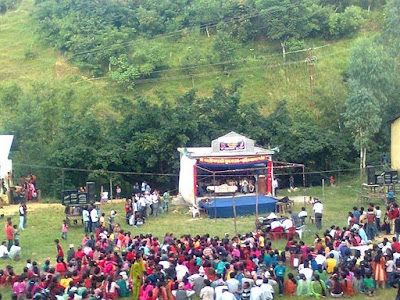
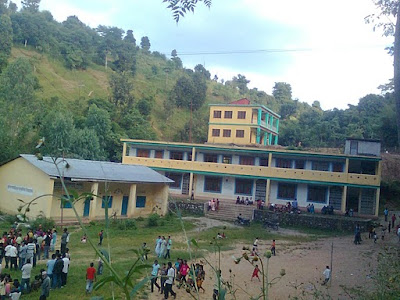
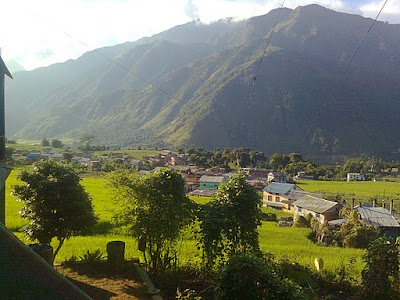
2.You are in The way of "BIRGHA"
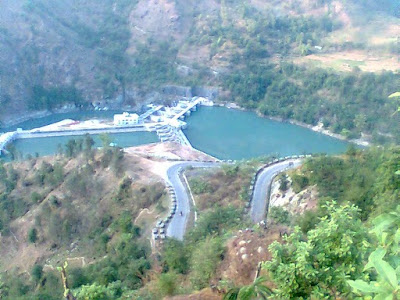 and harmicharu But you are looking Gulmi harmicharu named "Thulo lumpak " or Deurali from syangja mirmee.
and harmicharu But you are looking Gulmi harmicharu named "Thulo lumpak " or Deurali from syangja mirmee.
We caindly req to present .. our meating from
We look forward to meeting you at BTH in Mirmi, Syangja on Friday, March 21 10:15-12:00 in room 5320 for your introduction meeting to the LCDM Program. At this time you will meet your teachers and learn more about our program. If you are unable to attend the introduction, please use the contact information below to alert me of your absence.
Please note: Students who arrive after Sept 18th will not be allowed to join the program, so it is very important that you keep that in mind as you plan your travel and arrival in mirmi and alert me if are not able to attend the introduction.
Before we meet, I have prepared important information to help prepare you for this program. Please review this information carefully.
Faculty
During your first term in the LCDM Program you will have the following teachers and workshop leaders:
Madan bhattarai-Attaway
yugachandra bhattarai
Suvechha chand
salina chand
subas pandey
arunima bhandari Bäcke
Additional guest lecturers may be included in your courses.
Schedule/Classes
Generally, your lectures and seminars will take place between Monday and Friday mornings. Some group work may be assigned outside of class, and you may be required to meet your classmates outside of class to complete collaborative work. Additionally, film screenings and other activities may take place on Friday afternoons. Courses are held on campus, and we have strict attendance policies. You must be present on campus in your classes to receive full credit for courses, and excessive absenteeism will impact your grade and ability to receive credit for courses.
The first two LCDM courses you will take are:
1) Language and Communication 1, an introduction to grammar, writing, and oral communication in English. This course begins on Sept. 7th 2009 and will run until mid-January 2010.
2) Media Form and Design, a course introducing you to principles of effective graphical design and media technologies. This course begins on Sept. 8th 2009 and runs until the last week in October, 2009.
You must purchase the following texts before arriving to campus for the Language and Communication 1 Course:
Good Reasons: Researching and Writing Effective Arguments (4th Edition, Paperback) by Lester Faigley and Jack Seltzer
Making Sense of Grammar by David Crystal.
Design Basics for Creative Results by Bryan L. Peterson
Starting Dates For Courses:
Language and Communication 1 will begin on Monday, September 7th at 10.15 in Room 5320 and Media Form and Design will begin on Tuesday, September 8th at 10.15 in Room 5320. You will receive a detailed schedule at our introductory meeting outlining the specific readings and assignments for your courses.
Examinations
Students will complete oral, written and digital work as part of their course examinations. All instruction and examination work is in English.
Computers and Technical NeedsStudents are recommended to bring their own computer laptops with wireless network capabilities and internet software to complete work in class and other assignments. Ideally, students should have the following applications installed on their laptops: current
Power is generated or "manufactured"

Power is generated or "manufactured" in large power generating stations using the same basic principle as a small grist mill yet on a much larger and vastly improved scale for better efficiency. These electrical generators are attached to massive turbine devices which spin at great speeds as a result of water rushing through them. These power station turbines are much more efficient at extracting the kinetic energy from the moving water and converting that energy it into power through these generators.
The Hydro Electricity extracted from water depends not only on the volume but on the difference in height between the source and the water's outflow. This height difference is called the head. The amount of potential energy in water is directly proportional to the head. To obtain very high head, water for a hydraulic turbine may be run through a large pipe called a penstock.
For instance, energy is derived to make power by the force of water moving from a higher elevation to a lower elevation through a large tube" otherwise known in technical terms as a "penstock". When the water reaches the end of the penstock, it turns a water wheel or "turbine" at enormous speeds. The turbine rotates, via a connected shaft to an electrical generator, and this generator creates electricity. It is the turbine and generator working in combination that converts "mechanical energy" into "electric energy". The water that makes this possible, is a renewable energy resource, just like the wind that turns the turbine attached to a generator.
Hydro Electricity may be extracted from water but it depends not only on the volume of water but also on the difference in height between the top of the penstock and where the water spins the turbine. This difference in height is often referred to as the "head". From this "head", it can be determined the exact amount of potential energy that can be converted. Therefore, it is advantageous to build power dams as high as possible to convert the maximum energy from mechanical energy.
While many Hydro Electricity generating stations supply world power grids, some projects are created for private business purposes. For example, aluminium manufacturing companies require large amounts of power. And there are many other examples of industries that use hydro electricity in their manufacturing operations.
Comment me at 9849030857
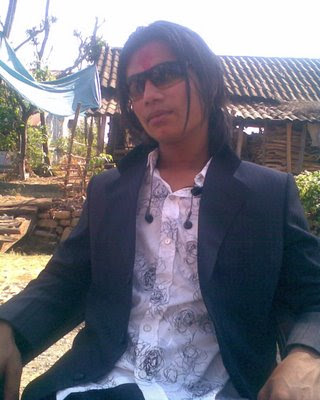
Namaste it's me Gopal mera creation haru kasto lag6 plz ramro lage sathi harulai herna bhannu parne hun6 n naramro lage malai bhandinu These live images haru mero birth place chinauna use bhayeka huna sak6na.
Comment me at
Gopal pandey 9849030857 And message at deletegopal@gmail.com
Tapai haruka sujhav n sallha haru bata best comment lai special gieft ko pani bebasta gariyeko 6. you can mail me also psycovirous_gp3@yahoo.com
Effects of Dams - Reasoning for conceptualizing alternatives
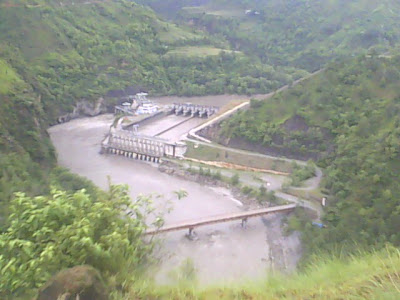
Future Directions for the Hydroelectric Industry
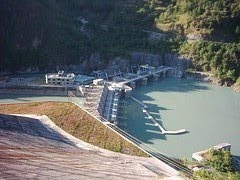
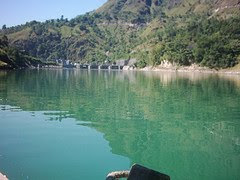 The hydroelectric industry has been termed "mature" by some who charge that the technical and operational aspects of the industry have changed little in the past 60 years. Recent research initiatives counter this label by establishing new concepts for design and operation that show promise for the industry. A multi-year research project is presently testing new turbine designs and will recommend a final turbine blade configuration that will allow safe passage of more than 98 percent of the fish that are directed through the turbine. The DOE also recently identified more than 30 million kilowatts of untapped hydroelectric capacity that could be constructed with minimal environmental effects at existing dams that presently have no hydroelectric generating facilities, at existing hydroelectric projects with unused potential, and even at a number of sites without dams. Follow-up studies will assess the economic issues associated with this untapped hydroelectric resource. In addition, studies to estimate the hydroelectric potential of undeveloped, small capacity, dispersed sites that could supply electricity to adjacent areas without connecting to a regional electric transmission distribution system are proceeding. Preliminary results from these efforts have improved the visibility of hydroelectric power and provide indications that the hydroelectric power industry will be vibrant and important to the country throughout the next century.
The hydroelectric industry has been termed "mature" by some who charge that the technical and operational aspects of the industry have changed little in the past 60 years. Recent research initiatives counter this label by establishing new concepts for design and operation that show promise for the industry. A multi-year research project is presently testing new turbine designs and will recommend a final turbine blade configuration that will allow safe passage of more than 98 percent of the fish that are directed through the turbine. The DOE also recently identified more than 30 million kilowatts of untapped hydroelectric capacity that could be constructed with minimal environmental effects at existing dams that presently have no hydroelectric generating facilities, at existing hydroelectric projects with unused potential, and even at a number of sites without dams. Follow-up studies will assess the economic issues associated with this untapped hydroelectric resource. In addition, studies to estimate the hydroelectric potential of undeveloped, small capacity, dispersed sites that could supply electricity to adjacent areas without connecting to a regional electric transmission distribution system are proceeding. Preliminary results from these efforts have improved the visibility of hydroelectric power and provide indications that the hydroelectric power industry will be vibrant and important to the country throughout the next century.The Hydroelectric Industry Stabilizes 1986–2000
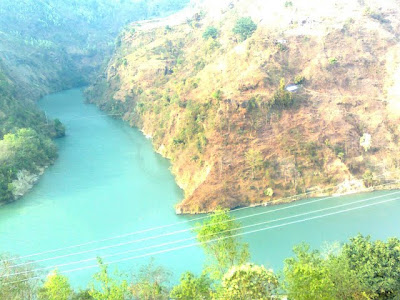
The recent availability of cheap natural gas and the minimal permitting requirements for gas-fired electricity generating plants has resulted in a dramatic increase in the construction of these plants. These gas-fired plants are meeting the increasing electricity demand more economically than other generating resources.
In today's climate of increased environmental awareness, the construction of new dams is often viewed more negatively than in the past. Therefore, the construction of a new dam for hydroelectric generation is rare. Only six hydroelectric projects were constructed between 1991 and 2000 with new dam or diversion structures and all of these structures are less than 30 feet (10 meters) in height. Hydroelectric facilities are installed at only about 2 percent of the nation's dams.
August 21, 2009
Mirmee Syanga biggest Hydroelectricity project

End of the 1989's search about this by the japanese,itilyan,chinese enginers and they are agree to make hydroproject. There are two mostly benifit for the toucher area one of them is pond or lake.When the dam made it make a larg pond where 9larg and 10small seambar and 13 boat are running off and on.
August 19, 2009
Mirmi,Harmichaur,Arbeni,Setibeni & Bridge
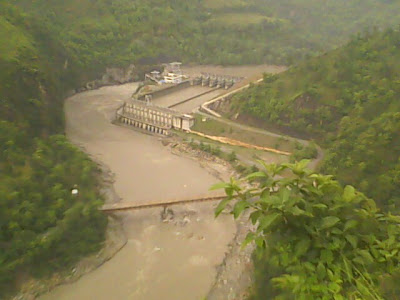 KaliGandaki river and dam site Hydroelectricity of Mirmi syangja. All work of this Hydroelectricity project was finished in 1999.
KaliGandaki river and dam site Hydroelectricity of Mirmi syangja. All work of this Hydroelectricity project was finished in 1999.This river saperet the two district of here which is "HARMICHAUR"(harmichaur) left hand site and Syangja in right site.Harmichaur is also tourist area there are helpful people.Way of Arbani,Satibeni,Parbat is also start from here.You may see bridge in picture which is also made in project time.
The power of Water how Danger it .
The power of water........water flowing in road when it is very (heavy rain ) Repoted by Gopal andey with Bhuwan pandey in 2066's assad rain. People and vechial passing without any frighten of . We may be trying to make hydroproject if it takes forever..........here are many of original river but many of them not usese.
August 18, 2009
Steamber & Boat are available in mirmee
A corner of Mirmee Syangja

August 17, 2009
River for elericity.
July 19, 2009
Village of mirmee & MIrmee multiple campus
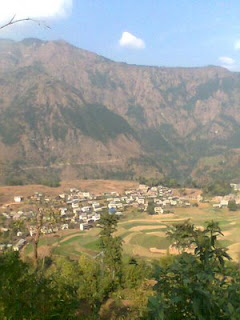

A part of mirmi's beautiful and acctractable place. 1 km far from Dam side.Which image taken from dabchhe hill of mirmi.
2. gopal pandey guides national and international tourists for educational practical of 50 marks. there is no any tension for travel, you can ask to anyone for help, they will be totally co-operate you about there.
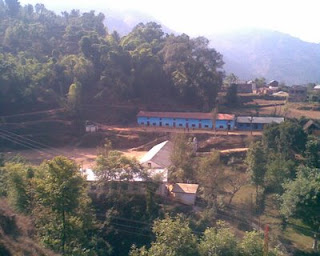
Last Member of this month & winner
July 17, 2009
July 2, 2009
'Kaligandaki river' 'Natural-view'


'Kaligandaki river' 'Natural-view' u can see boats n steembars in middle of the river u can also travell of there (7KM north in water ) a small cost of ur money .Also you can enjoy at boating small fee per/hrs. less then 5 people in boat n less then 200 people in steember, swiming cote is nessecary to wear.
After 7km north there is a popular Tample or salikram god within river.Everytime u can warship n pary. Your desire will be comes out in true is people believes in there.
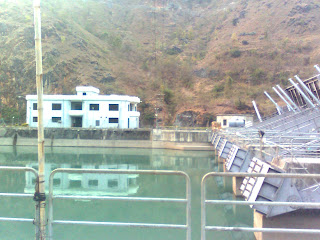 Power house in the middle of The kali-Gandaki river n hydro elericity project at Syangja mirmee which is 144 MW and biggest of Nepal yet.U can enter some allowed place if u have permission.You can get permission easly without any cost.But you fallow some rules n regulers.
Power house in the middle of The kali-Gandaki river n hydro elericity project at Syangja mirmee which is 144 MW and biggest of Nepal yet.U can enter some allowed place if u have permission.You can get permission easly without any cost.But you fallow some rules n regulers.
June 30, 2009
Help 100% no trouble
Find Us On Facebook
Nepali News paper
Submit your site
computer


















